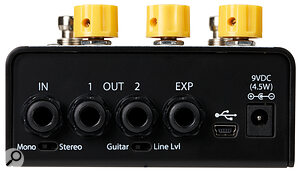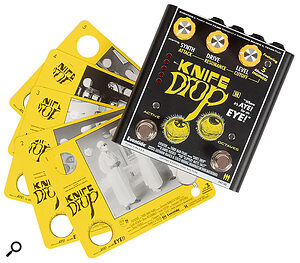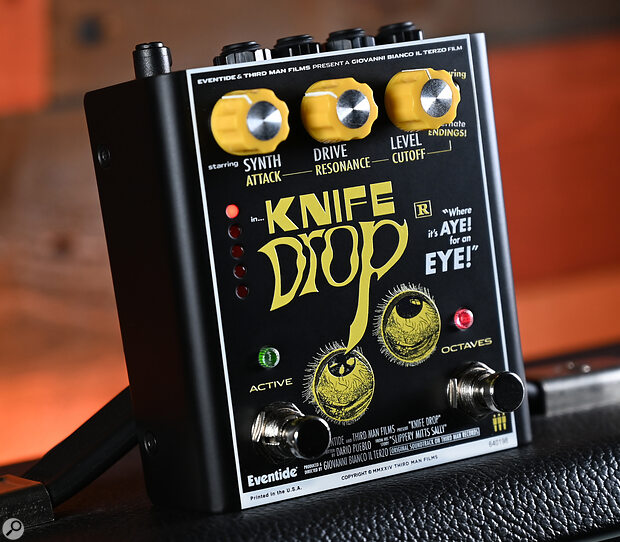Part fuzz, part guitar synth, this quirky pedal was conveived with horror soundtracks in mind. But it’s not a one‑trick pony...
This pedal is nasty: good‑nasty! Half monophonic synth, half drive/fuzz pedal, the new Knife Drop is a collaboration between Eventide and Third Man, and despite the small footprint it can deliver massive walls of sound. The pedal is themed around Italian giallo films of the 1960s and ’70s, with a seemingly fictional backstory about working closely with an Italian film director, Giovanni Bianco (consider who that might translate to in English...), to recreate the sound of his horror film soundtrack. There’s a lot of creativity going into the aesthetic and presentation of the pedal, and it complements well the sounds that it’s capable of producing.
Knife Edge
The Knife Drop stands out amongst a family of mono guitar synth pedals that now dates back decades, a category full of unique oddball pedals such as the Line 6 Filter Modeler, Digitech’s Meatbox sub synth, the Alesis Deep Impact, Way Huge’s Atreides and, the grandfather of the bunch, the Electro‑Harmonix Micro Synth, to name just a few. These each aim to make a guitar sound like a monosynth, but without the need for any special pickup, as is required by the ‘guitar synths’ made famous by Roland and Boss. This pedal isn’t trying to recreate the sound of any classic, unobtainable analogue synth or any of the pedals I just mentioned, and I appreciate that in a time when so many pedals are harking back to retro classics instead of creating an identity of their own. Sure, the combination of octave up, sub‑octave and synth‑type square‑wave distortion to create a monophonic synth/distortion pedal has shown up in different pedals over the years, but the Knife Drop’s user interface is not only very intuitive, it’s also unique.
The primary user controls are Synth/Guitar Mix, Drive and Level, and there are secondary functions for each knob — Attack, Resonance and Cutoff, respectively — to control the filter envelope settings, with the last one setting the starting frequency of the filter sweep. There’s an octave switch too, which gives the option of adding an upper octave only or both an upper and a sub‑octave. With the Octaves switch in red mode you get three notes: sub octave, original note and upper octave. Green indicates that you’ll hear an upper octave plus the original note.
 Like most Eventide pedals, the Knife Drop can operate at instrument or line level.
Like most Eventide pedals, the Knife Drop can operate at instrument or line level.
The back panel of the pedal hosts a mono quarter‑inch jack input, stereo jack output, an expression pedal socket, a TRS auxiliary footswitch or TRS MIDI socket, a USB port (for MIDI over USB and software updates), and a switch to set the pedal to instrument or line‑level operation. It’s also capable of connecting to Eventide’s H90 Control for remote desktop operation of routing, preset management and more.
I found that what sets this pedal apart from others in this category is the switch that allows the filter to be pre‑ or post‑drive. This single switch morphs the pedal from being a more classic‑sounding analogue synth, to a gnarly, edgy synthy dirt pedal that, when the filter is placed pre‑drive, is on the brink of destruction. The filter envelope becomes much more extreme too, especially with the resonance cranked, in which case it delivers some wonderfully exaggerated resonant filter sweeps. An expression pedal then gives you another layer of control, opening up the sonic possibilities further. The expression input can be configured so that the pedal controls parameters individually or so that it morphs between two different sounds entirely — that’s a very effective way to create more malleable sounds with this pedal.
Presets & Pedals
 Overlay cards allow you to set up the presets (which can otherwise be accessed using an external footswitch) from scratch, and these double up as a helpful learning aid.
Overlay cards allow you to set up the presets (which can otherwise be accessed using an external footswitch) from scratch, and these double up as a helpful learning aid.
There are five presets for this pedal, but one drawback that I noticed when putting this pedal through its paces, and which some might view as significant, is that they are only accessible when using an external footswitch — only preset 1 can be recalled without one. Looking into this further, a reply by Eventide to a YouTube comment revealed that this was a deliberate decision: Jack White (or should that be Giovanni Bianco?) wanted an easy way to switch back to preset 1, which is his favourite. This is achieved by holding the Octaves footswitch down until the LED for the preset at the top of the list blinks.
While I do understand that this is what the artist wanted, I still think that there should really be an option for onboard preset selection; having to buy a separate footswitch to access the five presets isn’t ideal, especially given that the front panel makes it look like they’re directly accessible, and that the manual doesn’t state clearly that they aren’t. I thought for a while that I was doing something wrong! By the way, if you have this pedal and want to make your own footswitch, it’s an easy build and a nice first step into the DIY world: TRS jack, small enclosure, two momentary switches (DL4 replacement style), connect one lug of each switch to sleeve of jack, the other lug of each switch connects to tip or ring.
Sounds & Surprises
For those using the pedal without an external footswitch, there are five preset card overlays included in the packaging, and these outline the knob settings for each preset. I found this very helpful, not only in accessing the preset sounds, but also in learning how to create usable patches on the pedal more generally. Multiple combinations of the alternate functions with the Octaves switch or filter pre/post switch are possible within each preset, drastically changing their character.
I was pleasantly surprised to discovered two unexpected sounds when exploring this pedal’s range. The first one was when using the Knife Drop with the Synth all the way down and Drive all the way up, which created a gated, Velcro‑y fuzz pedal. Bringing the Octaves switch into play turns it into a huge three‑octave‑range fuzz or octave‑up fuzz, and the latter is more reminiscent of a Whammy or Eventide’s Harmonizer algorithms than an Octavia‑style octave‑up.
With the Knife Drop pedal being marketed as a horror film soundtrack in a box, I really hadn’t expected to be able to get such a ‘pretty’ sound out of it.
With the Synth level all the way down, the pedal is polyphonic, even with the Octaves switched on, which leads me to the next surprising sound... With the Synth level down, turning Drive down all the way or just adding a touch of it and adding in an octave‑up, you get a beautifully shimmering, slightly glitchy Whammy‑type octave up of the kind famously heard on Radiohead’s ‘Sail To The Moon’, and many other tracks. This discovery was a breath of fresh air when demo’ing this pedal, as it’s very clearly intended for loud, aggressive pentatonic riff‑rock, as most demonstrations out there display. With the Knife Drop pedal being marketed as a horror film soundtrack in a box, I really hadn’t expected to be able to get such a ‘pretty’ sound out of it.
Like all other guitar‑to‑synth modules, dating right back to the beginning with the Roland GR‑500, tracking has always been an obstacle when converting a guitar signal to a synthesized sound. The early analogue guitar synths benefited from the absence of analogue‑to‑digital conversion, which obviously adds some latency. Happily, the Knife Drop is fast, with very little latency, but as always with such devices, this pedal’s tracking demands clean playing technique if you’re to avoid glitches. It’s not the easiest pedal to play though fast, then, and it feels to me as though it’s intended primarily for mid‑tempo riffs, especially if the filter attack is set to have a slow rise.
So what of the nature of those glitches? When playing more than one note with the synth engaged they sometimes result in a random single note that’s unrelated to the two being played, or if playing a fifth, a lower octave note comes out. Sometimes happy ‘freak outs’ occur when playing multiple notes or allowing an open string to ring while playing another, so there’s some creative potential. But while some monosynth pedals try (and fail!) to play back multiple notes, sometimes resulting in ‘musical glitches’, that’s not possible with this pedal — it’s not capable of playing back more than one synth note at a time. It was very noticeable when I didn’t play cleanly enough for this pedal, resulting in some imperfect tracking, but I’d say that this is part of its ugly beauty!
The Drop Off
Overall, the Knife Drop achieves precisely what it sets out to achieve. As a signature pedal, it’s obviously very much sonically aligned with the artist’s style of music and intent, but it does have the possibility to expand past that with some creative tweaking. It’s the perfect pedal for ferocious guitar riffs, but it also has the ability to deliver a subtle beauty that may not be the original intention, but saves it from the trap of being a one‑trick pony. It would serve a film score to an Italian giallo film very well indeed.
Summary
An intriguing combination of fuzz pedal and guitar synth, the Knife Drop is a unique pedal, full of attitude and capable of some wonderfully original sounds.
Information
$299.
When you purchase via links on our site, SOS may earn an affiliate commission. More info...
When you purchase via links on our site, SOS may earn an affiliate commission. More info...


